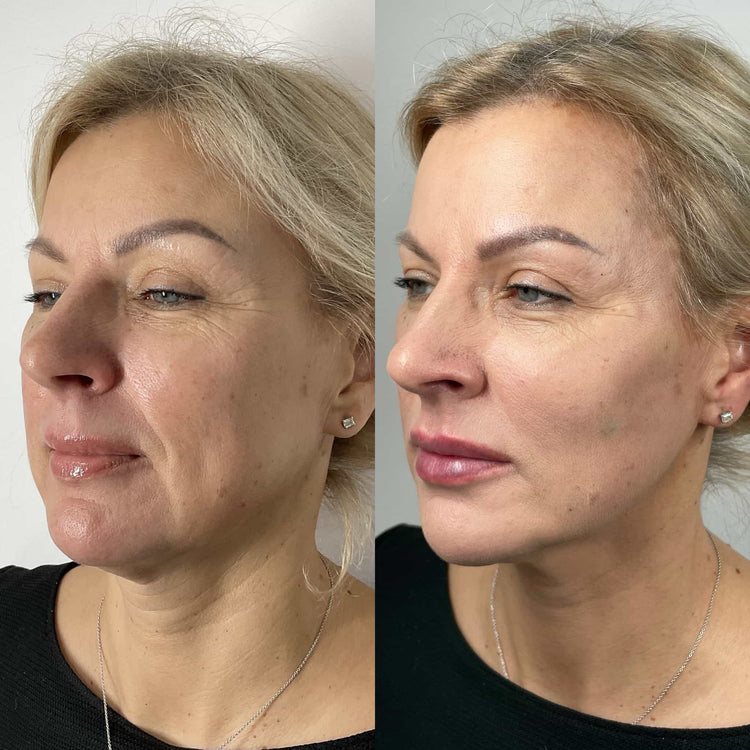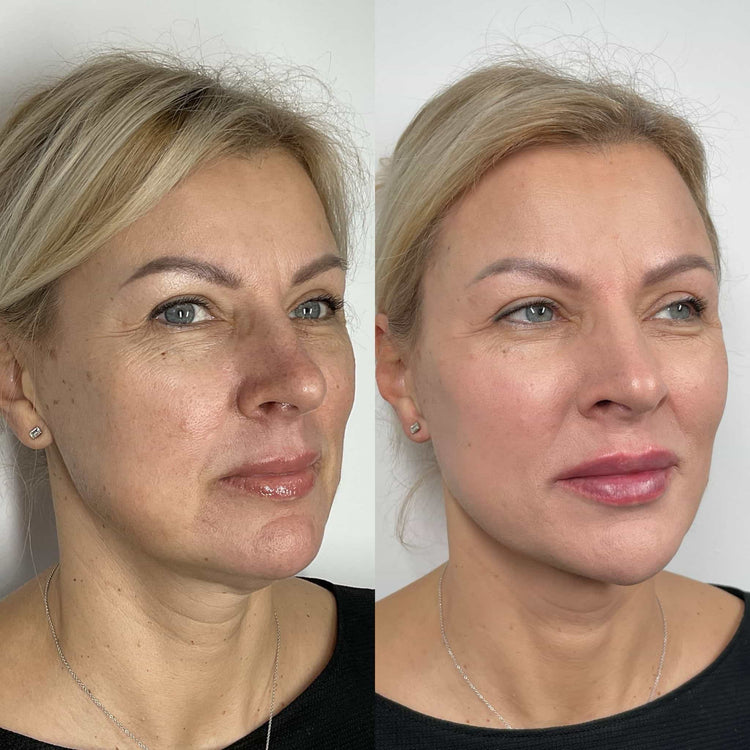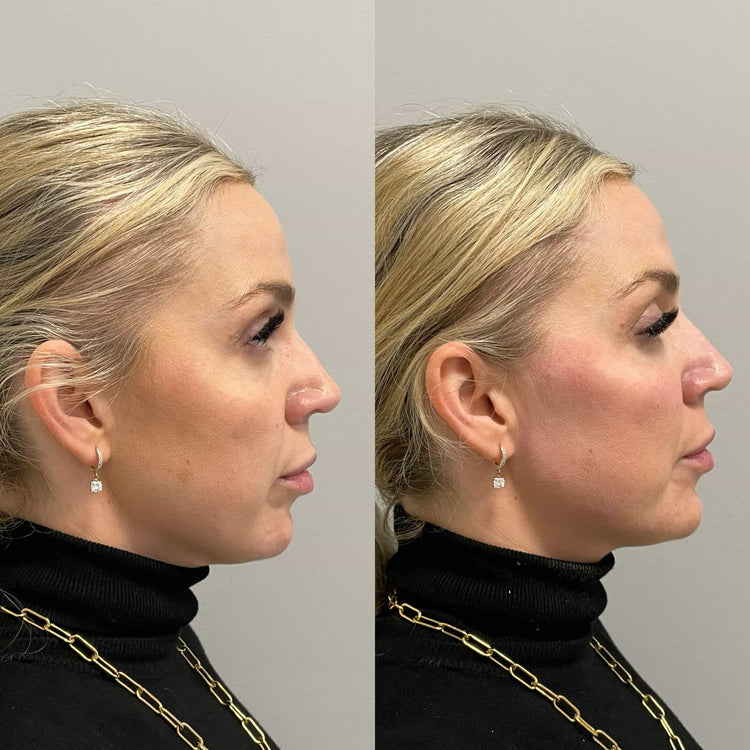The Science Behind Facial Symmetry
Facial symmetry has long been associated with beauty and attractiveness, often considered a sign of health and genetic fitness. This perception stems from our biological wiring: our brains are naturally drawn to patterns and order, and symmetrical faces are perceived as more balanced and aesthetically pleasing. However, the journey towards achieving perfect facial harmony doesn’t always align with nature’s design.
Dermal Fillers for Cheek and Jawline Enhancement
Fortunately, advancements in aesthetic medicine have provided innovative solutions for enhancing facial symmetry without resorting to invasive surgical procedures. Non-surgical liquid facelifts, utilizing dermal fillers, have emerged as a popular choice for addressing imbalances and creating a more harmonious facial profile.
Dermal fillers are injectable substances composed of hyaluronic acid, a naturally occurring substance found in the body that helps maintain skin volume and elasticity. These fillers work by strategically plumping up areas of the face that appear deficient, restoring lost volume, and smoothing out wrinkles or contours.

When it comes to cheek and jawline enhancement, dermal fillers can be particularly effective in correcting asymmetries. By adding volume to the cheeks, fillers can create a more defined and lifted appearance, balancing the proportions of the face. Similarly, injecting filler along the jawline can help define and accentuate this area, contributing to a more sculpted and symmetrical silhouette.
Botox to Correct Muscle Asymmetry
Botox, known for its ability to reduce wrinkles by relaxing muscles, also plays a role in achieving facial symmetry. Muscle imbalances can contribute to asymmetrical facial features. By strategically injecting Botox into specific muscles, a practitioner can counteract these imbalances. For example, if one side of the face shows more muscle activity than the other, Botox can be used to subtly weaken the stronger side, promoting a more balanced appearance.
The precise injection points and dosage depend on the individual’s unique facial structure and the specific asymmetry being addressed. Botox injections for symmetry correction are typically temporary, lasting several months before requiring repeat treatments to maintain the desired results.
Addressing Dynamic Wrinkles
Dynamic wrinkles, those that appear due to repeated muscle contractions, can also contribute to facial asymmetry. Over time, habitual expressions like frowning or smiling can cause muscles on one side of the face to develop more pronounced wrinkles than the other. This can lead to an uneven appearance, making the face look less symmetrical.
Dermal fillers can help address these dynamic wrinkles by adding volume and smoothing out the skin, effectively minimizing the appearance of asymmetry caused by muscle contractions.

Benefits of Non-Surgical Liquid Facelifts for Symmetry
Achieving facial symmetry is a common desire, often associated with beauty and harmony. While nature doesn’t always provide perfect balance, modern aesthetic treatments offer non-invasive solutions for enhancing facial contours and achieving a more symmetrical look.
Subtle, Gradual Results
Non-surgical liquid facelifts utilize dermal fillers to strategically enhance volume in areas that lack fullness or appear uneven. This can effectively address cheekbone asymmetry, creating a more balanced profile. Fillers also work wonders for the jawline, adding definition and structure, resulting in a more sculpted and symmetrical appearance.
Furthermore, these treatments offer subtle, gradual results. Unlike surgical procedures, liquid facelifts allow individuals to see how their features change over time. This allows for adjustments and fine-tuning throughout the process, ensuring a natural-looking and balanced outcome.
Minimal Downtime and Recovery
Liquid facelifts are particularly beneficial because they minimize downtime and recovery compared to surgical procedures. Patients can typically return to their normal activities soon after the treatment.
The minimally invasive nature of liquid facelifts means there is minimal discomfort, bruising, or swelling, resulting in a quicker recovery process. Patients may experience some mild redness or tenderness at the injection sites, which typically subsides within a few days.
Customized Treatment Plans
Non-surgical liquid facelifts offer numerous benefits for enhancing facial symmetry. By strategically injecting dermal fillers, practitioners can plump up areas that lack volume, restoring balance and creating a more harmonious profile.
Customized treatment plans are key to achieving optimal results. A skilled injector will assess individual facial structures, taking into account asymmetry, muscle imbalances, and desired outcomes. This personalized approach ensures that the right type and amount of filler is used in specific locations to correct imperfections and achieve a natural-looking enhancement.

Finding the Right Practitioner
Finding the right practitioner for non-surgical liquid facelifts is crucial to ensure safe and effective treatment.
Experience and Expertise with Facial Anatomy
When considering non-surgical liquid facelifts, it’s essential to choose a qualified and experienced practitioner who specializes in facial aesthetics.
- Experience and Expertise with Facial Anatomy: Look for a practitioner with extensive training and experience in facial anatomy and dermal filler techniques. They should have a deep understanding of how different muscles, tissues, and structures contribute to facial symmetry.
- Artistic Eye and Attention to Detail: Facial aesthetics requires an artistic eye and attention to detail. A skilled injector will be able to visualize the desired outcome and create a harmonious and balanced profile.
- Good Communication Skills: Effective communication is essential for ensuring that your expectations are understood and met. The practitioner should listen carefully to your concerns, explain the treatment process thoroughly, and answer any questions you may have.
Consultation and Personalized Assessment
Finding the right practitioner for non-surgical liquid facelifts is crucial to ensure safe and effective treatment. Look for a qualified and experienced practitioner who specializes in facial aesthetics. Their expertise in facial anatomy is essential, as they need to understand how different muscles, tissues, and structures contribute to facial symmetry.
A skilled injector will have an artistic eye and attention to detail, allowing them to visualize the desired outcome and create a harmonious and balanced profile. Good communication skills are also important. The practitioner should listen carefully to your concerns, explain the treatment process thoroughly, and answer any questions you may have.
During your consultation, be prepared to discuss your aesthetic goals and any specific concerns you have about facial symmetry. The practitioner will examine your face, taking note of muscle imbalances, areas of volume deficiency, and existing wrinkles. Based on their assessment, they will recommend a personalized treatment plan that outlines the type and amount of dermal fillers needed to achieve your desired results.
A comprehensive consultation will also cover any potential risks or side effects associated with liquid facelifts and address any questions you may have about the procedure and recovery process. Remember, choosing a qualified and experienced practitioner is essential for ensuring a safe and successful outcome in achieving your facial symmetry goals.
Maintenance and Longevity
Maintenance of non-surgical liquid facelifts involves following post-treatment instructions provided by your practitioner. This typically includes avoiding strenuous activity, excessive sun exposure, and certain skincare products that could irritate the injection sites.
The longevity of results depends on several factors, including the type of dermal filler used, individual metabolism, and lifestyle habits. Hyaluronic acid fillers, commonly used in liquid facelifts, tend to last between 6 to 18 months. During this time, the body gradually breaks down the hyaluronic acid, causing the effects to diminish.
Repeat treatments are necessary to maintain the desired results. The frequency of touch-up appointments will vary based on individual factors and the specific area treated. Most patients opt for repeat treatments every 6 to 12 months to ensure a consistent and youthful appearance.
- Why Does Lip Filler Look So Bad - November 10, 2025
- What Is The Best Tear Trough Filler - November 9, 2025
- What Are The Best CBD Gummies For Reducing Pain And Inflammation - November 7, 2025
